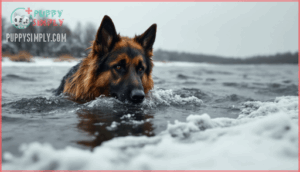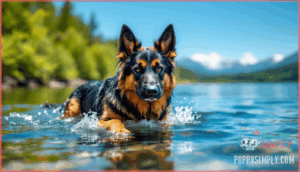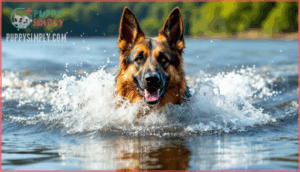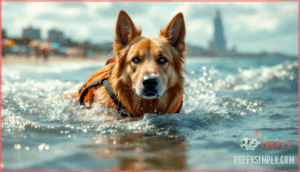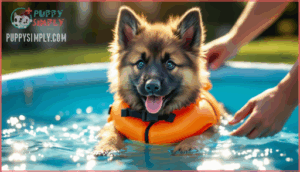This site is supported by our readers. We may earn a commission, at no cost to you, if you purchase through links.

While German Shepherds possess the physical tools for swimming—strong legs, webbed feet, and natural buoyancy from their double coat—their relationship with water depends heavily on early exposure and individual temperament. Some will leap into pools with abandon, while others need patient encouragement to venture past ankle-deep.
Understanding your dog’s anatomy, recognizing cold-water risks like hypothermia and limber tail syndrome, and using gradual positive reinforcement can transform swimming from a nerve-wracking unknown into a safe, enjoyable activity that draws on your shepherd’s natural athleticism.
Table Of Contents
- Key Takeaways
- Do German Shepherds Like to Swim?
- Can German Shepherds Swim in Cold Water?
- Are German Shepherds Natural Swimmers?
- How Long Can a German Shepherd Swim?
- How Fast Can a German Shepherd Swim?
- How to Get My German Shepherd to Swim?
- Why Should I Not Let My German Shepherd Swim?
- Can a German Shepherd Swim in The Pool?
- Can German Shepherds Swim in The Ocean?
- Can German Shepherd Puppies Swim?
- Frequently Asked Questions (FAQs)
- Are German Shepherds good swimmers?
- Can German Shepherds swim in cold water?
- Do German Shepherds hate water?
- How do you teach a German Shepherd to swim?
- How do I get my German Shepherd used to water?
- What is the average swimming speed of a German Shepherd?
- How deep can German Shepherds swim underwater?
- What health benefits does swimming provide for German Shepherds?
- Are German Shepherds good at dock diving competitions?
- What safety gear should be used when a German Shepherd swims?
- Conclusion
Key Takeaways
- German Shepherds have physical swimming advantages (webbed feet, strong legs, buoyant double coat) but aren’t natural water dogs—their comfort depends heavily on early positive exposure and individual temperament rather than breed instinct alone.
- Cold water below 45°F poses serious risks including hypothermia, limber tail syndrome, and muscle tightness, with safe swimming requiring temperatures around 70°F and sessions limited to 5 minutes in water below 50°F.
- Healthy adult German Shepherds typically swim 15-45 minutes at 1-2 mph, but age, health conditions like hip dysplasia, and water temperature significantly affect their endurance and should guide session length.
- Teaching reluctant swimmers requires starting in shallow water where paws touch bottom, using life vests for confidence, and applying gradual positive reinforcement with treats—never forcing entry, which creates lasting fear rather than water enjoyment.
Do German Shepherds Like to Swim?
Ever wonder if your German Shepherd sees a lake as a playground or a no-go zone? It really depends on the individual dog. While German Shepherds aren’t bred specifically for water work like some dog breeds, they’re athletic and capable swimmers once they’re comfortable.
The catch? Water preference varies wildly based on individual personalities and early experiences. A puppy introduced gently to water with treats and praise often grows into a confident swimmer, while one pushed too quickly may develop lasting hesitation.
Training influence matters here—positive reinforcement turns swimming into fun rather than stress. Never toss your dog into water; that’s a recipe for fear. Breed tendencies suggest German Shepherds can enjoy water activities, but respect your dog’s unique comfort level. With patience, most discover their inner water dog.
Positive reinforcement makes swimming enjoyable for German Shepherds, but never force them into water—respect their comfort level and let them discover it naturally
Can German Shepherds Swim in Cold Water?
Your German Shepherd’s double coat provides some cold water protection, but don’t let that fool you—cold water swimming carries real risks. Water temperature matters more than you might think. Around 70°F is ideal, but anything below 45°F should be off-limits completely. One key factor is dog’s cold tolerance, which varies by breed and individual.
Here’s what happens when German Shepherds swim in cold water:
- Hypothermia develops quickly—body temperature drops within minutes, especially in water under 50°F
- Muscle tightness increases—cold causes contraction that can lead to tears or reduced mobility
- Limber tail syndrome becomes more common after cold water exposure
- Breathing patterns change—rapid breathing may slow dangerously with continued exposure
- Age matters greatly—puppies and seniors can’t tolerate cold like healthy adults
Cold tolerance varies by individual, but even thick-coated adults shouldn’t swim longer than 5 minutes in water below 50°F. Puppies need warm weather only. Always dry your dog immediately after swimming—wet fur continues dropping body temperature even on land.
When temperatures dip, skip the swim entirely. Frostbite and hypothermia aren’t worth the risk.
Are German Shepherds Natural Swimmers?
German Shepherds aren’t natural swimmers like Labradors or Poodles. They were bred for herding, not aquatic work. That said, their physical traits give them solid aquatic advantages: strong legs for propulsion, webbed feet for better movement, and a double coat that adds buoyancy.
While all dogs instinctively paddle when submerged, swimming limitations vary by individual. Some take to water confidently; others need gradual training. Physical factors like age, health, and body structure affect breed swimming ability. Dogs with overly sloped backs may struggle with balance. Swimming is great exercise, helping improve their physical and mental health.
| Advantages | Limitations |
|---|---|
| Long, powerful legs aid propulsion | Not bred for water work |
| Webbed feet improve water movement | Individual water aversion causes vary |
| Double coat provides buoyancy | Instinct vs training matters greatly |
| Elongated snout eases breathing | Some never enjoy swimming |
With patience and positive reinforcement, most German Shepherds learn to swim well—they just need your support getting started.
How Long Can a German Shepherd Swim?
Most healthy adult German Shepherds can swim comfortably for 15 to 45 minutes per session. That said, swimming endurance varies based on age influence—puppies and senior dogs tire faster due to developing or declining muscles. Health impact matters too; conditions like hip dysplasia or arthritis limit swimming ability. Water temperature plays a role: your dog swims best around 70°F, but prolonged exposure to cold water increases fatigue and hypothermia risk. Training effect is significant—gradually building stamina improves German Shepherd swimming abilities over time.
Always watch for signs of exhaustion and provide breaks. Dog swimming safety means knowing your dog’s limits and respecting them.
- Imagine this: Your German Shepherd paddling alongside you, tongue out, eyes bright—then suddenly slowing, legs moving less efficiently, signaling it’s time to head back to shore.
How Fast Can a German Shepherd Swim?
If you’ve ever watched your German Shepherd paddle through the water, you might wonder just how fast those powerful legs can propel them through the waves. Most German Shepherds swim at a steady pace of 1 to 2 mph—not breaking any records, but respectable for a land-loving breed. Factors affecting their speed include age, muscle development, and overall fitness. Puppies and seniors naturally swim slower due to less developed or declining strength, while dogs with health issues like cancer or arthritis can’t maintain the same pace.
Here’s what impacts your dog’s swimming speed:
- Body build – Leaner German Shepherds cut through water more efficiently than stockier ones.
- Water temperature – Cold water drains energy faster, slowing your dog down considerably.
- Training impact – Regular swimming builds endurance and improves speed over time.
Breed comparisons show German Shepherds don’t match water-bred dogs like Labradors, but their athletic abilities still shine through.
How to Get My German Shepherd to Swim?
Teaching a reluctant German Shepherd to swim doesn’t have to feel like pushing a boulder uphill—with the right approach, you can turn hesitation into confidence. Start in a kiddie pool or shallow area where your dog’s paws touch the bottom. This builds trust without overwhelming them. A properly fitted life vest gives extra buoyancy and security, especially during those first few attempts.
Positive reinforcement works wonders—bring high-value treats and favorite toys to reward even small steps forward. Toss a ball into ankle-deep water and praise every brave move toward it.
Here’s your step-by-step approach:
- Begin shallow – Let your German Shepherd explore at their own pace in calm, warm water around 70°F.
- Make it fun – Use toys and treats to create positive associations with water time.
- Increase depth gradually – Move to deeper areas only after your dog shows comfort and confidence.
Always supervise your German Shepherd during swimming sessions. Never force them in—patience creates lasting water lovers, not fearful swimmers.
Why Should I Not Let My German Shepherd Swim?
Swimming can present real dangers for German Shepherds, and knowing when to say no protects your dog from serious harm. Cold exposure below 45°F risks hypothermia and frostbite, while strong currents in rivers or oceans create drowning risks even for confident swimmers.
If your German Shepherd has hip dysplasia, degenerative disc disease, or arthritis, swimming can worsen joint pain despite being low-impact exercise. Waterborne illnesses like leptospirosis and giardia lurk in contaminated lakes and ponds, potentially causing severe infections.
Physical limitations matter too—puppies under 10 weeks, elderly dogs, and those with poor conformation struggle with buoyancy and tire quickly. Open wounds invite infection, and pool hygiene concerns arise from bacteria like E. coli accumulating in shared water.
When conditions look risky or your dog shows fear, trust your gut and choose safer alternatives.
Can a German Shepherd Swim in The Pool?
Your backyard pool can absolutely become your German Shepherd’s favorite workout spot—as long as you understand the chlorine factor and teach proper entry and exit skills. Pool chemicals irritate some dogs’ skin, causing redness or itching, so rinse your German Shepherd thoroughly after each swim.
You’ll need to show them where the steps are located—dogs naturally paddle toward edges but don’t instinctively understand how to exit, which creates drowning risks. Keep pool temperature around 70°F for comfortable swimming sessions. Never let your German Shepherd dive into the pool, since this risks injury and discomfort.
Supervised pool exercise builds strength without joint stress, making swimming pools excellent for German Shepherds in pools when you’re present. Clean swimming pool water regularly to prevent bacterial buildup, and always maintain pool safety by watching your dog closely throughout every session.
Can German Shepherds Swim in The Ocean?
Ocean swimming brings wave action, salt water, and tides into the mix—challenges that make your German Shepherd’s pool experience look like a warm-up lap. Ocean currents can exhaust even strong swimmers quickly, so you’ll need to limit sessions and stay close.
Saltwater dangers include salt poisoning if your dog drinks too much—watch for excessive thirst, vomiting, or disorientation afterward. Beach hazards like jellyfish, sharp shells, and unpredictable marine life require constant vigilance.
Rinse your German Shepherd thoroughly with fresh water after ocean training to remove salt that irritates skin and damages their coat. Start German Shepherds in the ocean during calm conditions with minimal waves, keeping sessions brief until they understand the environment. Always use a life vest for added safety, and never let your dog swim beyond your reach in unpredictable waters.
Can German Shepherd Puppies Swim?
German Shepherd puppies are natural paddlers from around 10 weeks old, but those tiny legs and developing muscles need your help to make their first splash a safe one. Start puppy swim training in shallow water—think kiddie pools or calm lake edges where their paws touch bottom. Early water introduction builds confidence, but you shouldn’t rush it. Wait until your German Shepherd puppy hits 3-4 months when coordination improves and muscles strengthen.
Always supervise puppy swimming closely—exhaustion sneaks up fast on young dogs. Keep sessions brief, around 5-10 minutes initially, and watch for signs of fatigue like frantic paddling or head bobbing. A puppy-sized life vest adds security while teaching. Warm water matters too—aim for 70°F to prevent chilling. With patience and positive reinforcement, your German Shepherd puppies will develop into confident swimmers who genuinely enjoy the water.
Frequently Asked Questions (FAQs)
Are German Shepherds good swimmers?
Imagine this: a graceful Shepherd leaping off a dock, paddle-churning through the lake with pure joy. German Shepherds can be good swimmers thanks to their athletic build and water-resistant coat, though individual enjoyment varies based on early training and positive experiences.
Can German Shepherds swim in cold water?
While German Shepherds can tolerate brief dips in cooler water, extended cold water exposure risks hypothermia—especially in puppies.
Keep water around 70°F for safe swimming; below 45°F poses serious health dangers requiring immediate avoidance.
Do German Shepherds hate water?
Not really—breed preferences vary widely among German Shepherds. Individual temperaments matter more than breed traits with respect to water aversion.
Early experiences, training impact, and dog behavior shape whether your dog develops fear of water or dog anxiety around it.
How do you teach a German Shepherd to swim?
Think of teaching swimming like building a bridge—you start with solid ground. Begin in a kiddie pool or shallow water, using positive reinforcement with treats and praise. Add a life vest for confidence, then gradually introduce deeper water.
Make it a positive experience through patient, supervised training sessions.
How do I get my German Shepherd used to water?
Start in a kiddie pool or shallow water with positive reinforcement like treats and praise. Use a canine lifevest for security, supervise always, and make gradual introduction key—especially for puppies or dogs with fear of water, assuring a positive experience when teaching dogs to swim.
What is the average swimming speed of a German Shepherd?
Most German Shepherds paddle between 1 to 2 mph—a leisurely pace supported by their athletic build.
Puppies and seniors swim slower due to developing or declining muscles, while health conditions like arthritis can further reduce speed in this naturally capable breed.
How deep can German Shepherds swim underwater?
German Shepherds can briefly dive 5-10 feet underwater, but diving dangers exist. Their breed limitations mean limited underwater endurance compared to water-adapted dogs.
Focus on safe depths during swimming sessions, and avoid diving training without supervision to guarantee water safety.
What health benefits does swimming provide for German Shepherds?
Swimming offers excellent joint support for your German Shepherd since water naturally cushions their joints. This low-impact exercise builds muscle strength and cardio fitness while supporting weight management—all without stressing aging or injured joints.
It’s particularly valuable as a rehabilitation aid for dogs recovering from surgery.
Are German Shepherds good at dock diving competitions?
While German Shepherds’ athletic builds and water-resistant coats position them as promising canine athletes for dock diving, their success depends heavily on training techniques and individual temperament.
With proper preparation, these dog breeds excel at competition readiness, launching powerfully off docks with their muscular frames and natural swimming abilities.
What safety gear should be used when a German Shepherd swims?
A well-fitted life vest is essential swimming safety gear for your German Shepherd, especially during initial water introductions. You’ll also want flotation devices nearby and rescue tools within reach—never let your dog swim unsupervised, regardless of experience level.
Conclusion
Picture your shepherd’s first confident paddle—head high, legs churning rhythmically, tail cutting through the water like a rudder. That image becomes reality when you respect their individual comfort level and prioritize safety over speed.
Whether your German Shepherd can swim isn’t just about breed capability—it’s about building trust through gradual exposure, recognizing anatomical strengths like webbed feet, and understanding when cold water or fatigue signals it’s time to exit.
With patience and proper precautions, you’ll discover an activity that channels their natural athleticism while strengthening your bond.
- https://a-z-animals.com/blog/yes-german-shepherds-can-swims-facts-about-these-strong-swimmers/
- https://tractive.com/blog/en/good-to-know/7-dog-breeds-that-absolutely-love-the-water
- https://pmc.ncbi.nlm.nih.gov/articles/PMC10475558/
- https://www.wpsgss.org/post/cancer-and-your-senior-german-shepherd-the-older-he-gets-the-greater-the-risk
- https://dogtime.com/dog-health/general/19237-hypothermia-in-dogs

